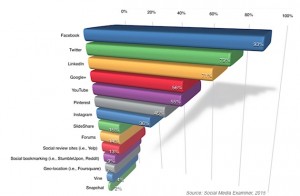
How does your professional bio back up your thought leadership strategy? Is it like a silent wingman that leaves you hanging? Or is it a reliable friend that boldly sings your praises to others? You need a bio that supports your business goals, and moves others to reach out to you.
The old saying still holds true: You only have one chance to make a first impression. It takes on a whole new meaning when you think of your professional bio on social media and your website. How does your first impression stack up?
It’s crazy when you think how much pressure is on those few lines of text. For starters, your professional bio has to sum up in a blurb your personality, expertise, and level of competence. It is the crossroads where people will decide whether or not to follow you on social media, do business with you, or even collaborate with you. That’s a whole lot of responsiblity for one blurb.
Bios range from straight-laced and professional to quirky and filled with personality. It really depends on your personal style and the message you want to convey to your readers. Let’s look into what factors should shape your bio, and how to craft one that gets the right kind of attention.
What is Thought Leadership, and Where Does My Bio Fit In?
If your goal is thought leadership, your professional bio can go a long way in helping you to achieve it.
What is thought leadership? It means being the go-to authority in your field, contributing meaningfully to the industry, and delivering consistent and exceptional results.The net result is that you become far better known and esteemed by peers, customers, and prospects.
How can a professional bio help put you on the thought leadership path?
When people hear your name, and want to know more about you, they will seek out information on your website and social media. The profile that they read there, if done strategically, should answer many of their questions, and convince them that you are a leading authority to follow.
Now the question is, how do you create a professional bio that will accomplish this?
A Professional Bio Worthy of Your Thought Leadership Strategy
1. Choose the Right Voice
There’s some debate whether to use first-person or third-person in a professional bio. There’s pros and cons to each. First person sounds more personable, but can seem braggy when you get into your various accomplishments. Third person, while it sounds professional, can sound detached and impersonal at times.
There’s no wrong answer here. We tend to write our bios in the third person because of the professional air it lends to the copy. Choose your voice, and just make it consistent throughout your bio.
2. Determine Your Primary Objective
How do you want the person reading your bio to perceive you? Is this meant to build confidence in potential customers? Would you like to attract industry leaders? Defining your goal early on can help you to stay on course as you write it.
For example, if your goal is thought leadership marketing, provide information on your accomplishments that shows your thought leadership ability. The whole idea of thought leadership marketing is to show, not tell, and to provide, not promote.
Boiled down, this means that your bio shouldn’t be self-promotional or salesy. It should state the facts, but the facts should strategically lead to a thought leadership conclusion.
You should never be the one to call yourself a thought leader — allow others to attribute that title to you.
3. Convey Real Value
At the heart of every great bio is the value it brings to the reader. What do you bring to the table? Is it a level of expertise and insight into your industry? Or is it a passion for the work that constantly drives you forward when others give up?
Find that one thing that sets you apart and makes you appealing to your audience. Then convey that throughout your bio.
The following questions will help you get started:
- What is your current role?
- What are your areas of expertise?
- Who are your clients, what challenges do they face, and what puts you in a unique position to help them?
- What makes you different from others in your industry?
Once you have the answers, you will more easily be able to define your value, and put it into words.
4. Be Authentically You
The goal with any professional bio is for people to get to know you, and feel like they can and want to reach out to you. Share appropriate details about your personal and professional life that will help people to see a broader picture of who you are. People can spot fake right away, so don’t write what you think people want to read — just be authentic.
5. Top it Off with a Nice Photo
Nothing sells your bio like a nice, clean, professional headshot. People want a face to put with the name and details that they read about you. It will help them remember you more clearly. Just remember to be consistent throughout your social media profiles and website.
Examples of Killer Bios We’ve Enjoyed
Want to see a few professional bios in action? Here’s a few that we’ve admired.
Joe Pulizzi
Joe Pulizzi, distinguished for his role as the founder of Content Marketing Institute, is a prominent thought leader in his field. Although the words “thought leader” never appear in his bio, the list of his accomplishments and ideals are a perfect depiction of the term.
Notice, he has separated his bio into short form and long form — for people who are looking for a quick scan, or those who really want to know more about his background.

Stephen Boyer
Stephen Boyer is the cofounder of a cybersecurity company called Bitsight. Actually, his whole team did a superb job with their bios — short, sweet, and to the point. As you hover over each picture, the person’s bio appears.
Stephen Boyer’s bio shows his accomplishments, his areas of specialization, and his educational background. And all of this, in a couple of sentences. This is the perfect bio for a company website, where it needs to be short to accommodate many individuals.

Ann Handley
Ann Handley, Chief Content Officer of MarketingProfs, is a supreme example of a social media bio. While Ann Handley is well known in her field, and has a long laundry list of accomplishments, she has carefully chosen what she wants to highlight about her background — with a little bit of humor thrown in for good measure.
In short, just because this is her professional bio doesn’t mean that she has to hide her personality. Her bio presents her so that you get to know the person, as well as her professional qualifications.

What professional bios do you admire?
Key Points to Remember…
- Show your thought leadership qualities — the idea is not to promote yourself as a thought leader, but to prove it.
- Convey real value to anyone who visits your bio — whether if it’s in your job role, your areas of expertise, or your differences.
- Be authetnic! People are naturally attracted to those who are transparent and real.
- Use a nice, clean, professional photo to showcase the person behind the description.
Business & Finance Articles on Business 2 Community
(157)








